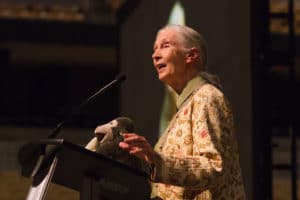Hello fellow readers, What a treat to hunker down to The Book of Hope by Jane Goodall and Douglas Abrams with Gail Hudson borrowed from the library. The subtitle— A Survival Guide for Trying Times. I don’t know about you, but merely surviving seems sad. I like to think of it as a Guide to Growing Hope instead.
Four Reasons for Hope
Published in 2021, essentially, The Book of Hope is a dialog with Jane Goodall about her reasons for hope despite the world’s increasing troubles. She has four of them that she intimately shares.
One of the reasons for hope is The Resilience of Nature. Goodall feels we still have time to turn things around despite our neglect and disregard for preserving and caring for mother earth.
She considers herself a naturalist rather than a scientist though Goodall is that too.
“The naturalist,” Jane said, “Looks for the wonder of nature – she listens to the voice of nature and learns from nature as she tries to understand it.”
She goes on to say, “As a naturalist, you need to have empathy and intuition—and love.” And awe, she adds as the dialogue unfolds.
Jane Goodall’s Timeless Commitment
The book cover portrait of Jane Goodall, at almost ninety years, with her soulful eyes displays her timeless commitment and love for the world around us and the animals and plants that live in it. She’s most known for her study of chimpanzees and her mission to protect them by protecting their habitats.
In her research about the decline of chimpanzees, she observed that by restoring and improving the environment, planting trees and other indigenous plants, and letting them colonize, the population of chimpanzees and other wildlife grew too.
It works much like the Successional Forest we talked about a while back at Lodestar Park in Fredon, NJ (link below). Through a natural succession of stages over time, the land returns to an ecologically balanced state given no other manufactured or natural setbacks. But we can nurture nature and encourage a quicker recovery.
A Guide to Growing Hope
“Hope does not deny the difficulty and all the danger that exists, but it is not stopped by them. There is a lot of darkness, but our actions create the light,” Jane Goodall said. She explains that each of us can make a difference by taking action. And by doing so, you’ll inspire others to do the same.
I hungrily absorbed Jane Goodall’s other three reasons for hope: The Amazing Human Intellect, The Power of Young People, and The Indomitable Human Spirit, which I talk about in the expanded version of this story in Episode 44 of our podcast (link below). And I look forward to how the book will conclude.
We can all do our part by cleaning up the world around us, picking up trash along the road, stopping the use of pesticides and other toxic chemicals, and planting native plants. We can all do our part by nurturing nature and letting it be. The balance of nature is perfect if we allow it.
Our 500th anniversary
If I may close by sharing, this story marks the 500th anniversary of our weekly chats. I recall that five hundred columns seemed like a reasonable goal when we began. And here we are. But It occurs to me we have more dilemmas, delights, and discoveries in this garden of life to share. I look forward to moving forward with you in the spirit of growing hope and love. Thank you, kind readers, and our local paper, for the privilege.
Garden Dilemmas? AskMaryStone@gmail.com (and on your favorite Podcast App.)
You’ll enjoy the expanded version of this story on the podcast link below.
Link to the previous story about Successional Forest and a story you’ll enjoy about the benefits of picking up litter.
Links for more about Jane Goodall Institute and Roots and Shoots




